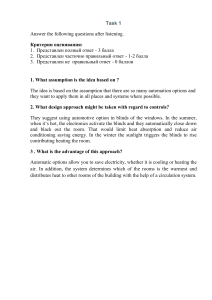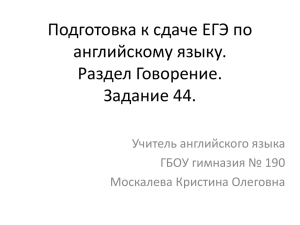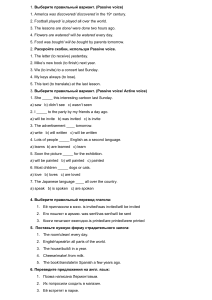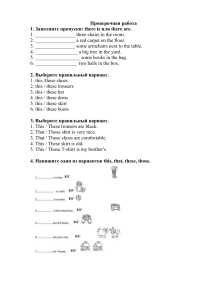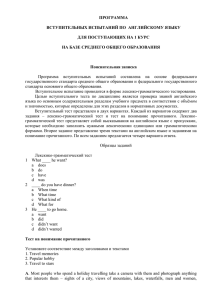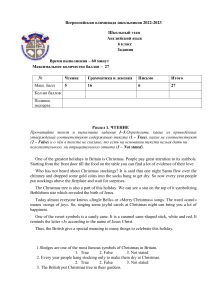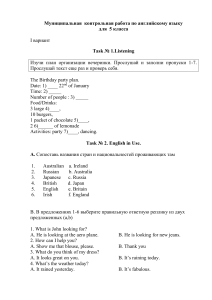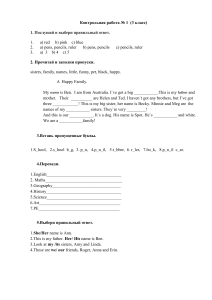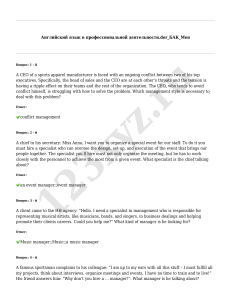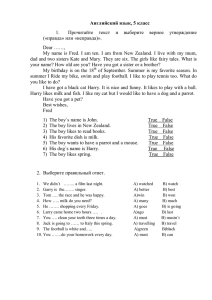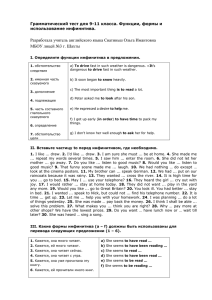Topic 7 Premenstrual syndrome. Pathogenesis, clinical forms, diagnosis and treatment
реклама
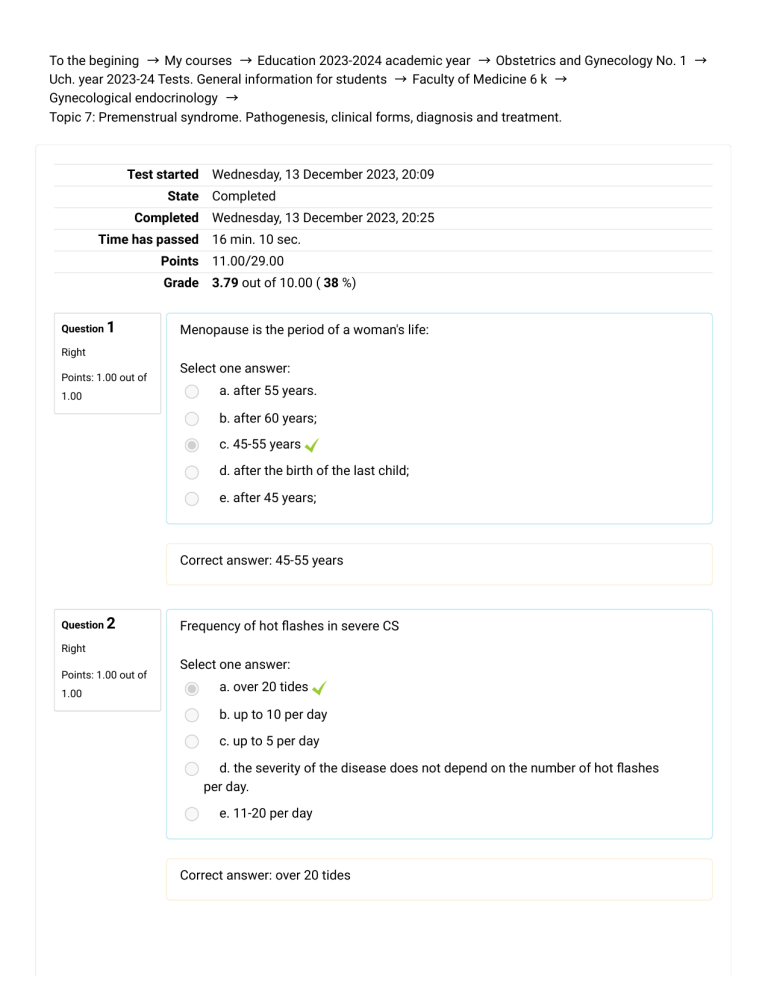
→ → → To the begining My courses Education 2023-2024 academic year Obstetrics and Gynecology No. 1 Uch. year 2023-24 Tests. General information for students Faculty of Medicine 6 k Gynecological endocrinology Topic 7: Premenstrual syndrome. Pathogenesis, clinical forms, diagnosis and treatment. → Test started → → Wednesday, 13 December 2023, 20:09 State Completed Completed Time has passed Question 1 Wednesday, 13 December 2023, 20:25 16 min. 10 sec. Points 11.00/29.00 Grade 3.79 out of 10.00 ( 38 %) Menopause is the period of a woman's life: Right Points: 1.00 out of 1.00 Select one answer: a. after 55 years. b. after 60 years; c. 45-55 years d. after the birth of the last child; e. after 45 years; Correct answer: 45-55 years Question 2 Frequency of hot flashes in severe CS Right Points: 1.00 out of 1.00 Select one answer: a. over 20 tides b. up to 10 per day c. up to 5 per day d. the severity of the disease does not depend on the number of hot flashes per day. e. 11-20 per day Correct answer: over 20 tides → Question 3 Manifestations of urogenital atrophy do not include: Right Points: 1.00 out of 1.00 Select one answer: a. vaginal dysbiosis; b. hot flashes; c. dyspareunia; d. dryness of the vaginal mucosa; e. itching and burning; Correct answer: hot flashes; Question 4 For hormonal therapy of premenstrual syndrome, the following are used: Right Points: 1.00 out of 1.00 Select one answer: a. gestagens b. combined oral contraceptives; c. parlodel; d. corticosteroids; e. androgens Correct answer: combined oral contraceptives; Question 5 Wrong Points: 0.00 out of 1.00 Clinical manifestations of premenstrual syndrome (on the eve of menstruation) do not include: Select one answer: a. headache, dizziness b. painful breast engorgement c. depression, sometimes aggressiveness d. anorexia e. weight gain of 1-2 kg. Correct answer: anorexia Question 6 Right Points: 1.00 out of 1.00 In postmenopausal patients with climacteric syndrome, there is usually an increase in the level of: Select one answer: a. FSH b. cortisol c. TSH d. prolactin e. insulin Correct answer: FSH Question 7 Wrong Points: 0.00 out of 1.00 Which of the following menopausal symptoms does not disappear during menopausal hormone therapy with estrogen: Select one answer: a. depression; b. atrophic colpitis; c. prolapse of the vaginal walls; d. insomnia; e. frequent urination. Correct answer: prolapse of the vaginal walls; Question 8 The concept of “window of therapeutic opportunity” includes: Wrong Points: 0.00 out of 1.00 Select one answer: a. the period of menopausal transition and 2 years after the last menstruation in life; b. Juvenile period c. period of menopausal transition and early postmenopause. d. perimenopause; e. the period of menopausal transition and the first 10 years after the cessation of menstruation; Correct answer: menopausal transition and early postmenopause. Question 9 The duration of the menopausal transition (perimenopause) is: Wrong Points: 0.00 out of 1.00 Select one answer: a. 2 years; b. 3 years; c. 1 year; d. 10 years; e. 5 years; Correct answer: 5 years; Question 10 Neurovegetative manifestations of menopausal syndrome do not include: Wrong Points: 0.00 out of 1.00 Select one answer: a. dryness and atrophy of the skin and mucous membranes; b. heartbeat; c. hot flashes; d. night sweats; e. dizziness; Correct answer: dryness and atrophy of the skin and mucous membranes; Question 11 The most effective treatment for postmenopausal osteoporosis is: Wrong Points: 0.00 out of 1.00 Select one answer: a. diet therapy; b. hormone therapy; c. prescription of drugs - bone resorption inhibitors. d. vitamin therapy; e. physiotherapy and exercise therapy; Correct answer: hormone therapy; Question 12 Right Points: 1.00 out of 1.00 Specify the most effective method for early diagnosis of postmenopausal osteoporosis: Select one answer: a. radiography of the hand; b. CT scan; c. radiography of the lumbosacral spine; d. determination of the level of calcium and parathyroid hormone in the blood. e. osteodensitometry Correct answer: osteodensitometry Question 13 It is not typical for the atypical form of menopausal syndrome Wrong Points: 0.00 out of 1.00 Select one answer: a. severe diabetes mellitus b. sympathoadrenal crises c. endocrine infertility d. severe course of bronchial asthma e. transformed premenstrual syndrome Correct answer: endocrine infertility Question 14 Menopause is: Wrong Points: 0.00 out of 1.00 Select one answer: a. 1 year after the last menstruation in life; b. the period of life after the cessation of menstruation; c. the first 10 years after the cessation of menstruation; d. 2 years after the last menstruation in life; e. the first 5 years after the cessation of menstruation Correct answer: 1 year after the last menstruation in life; Question 15 Not used for hormone replacement therapy during menopause Wrong Points: 0.00 out of 1.00 Select one answer: a. "livial" b. “kliogest” c. "femoston" d. "klymen" e. "danazol" Correct answer: "danazol" Question 16 Characteristic metabolic and endocrine disorders in menopausal syndrome: Wrong Points: 0.00 out of 1.00 Select one answer: a. osteochondrosis b. anorexia c. thyrotoxicosis d. asthenic syndrome e. obesity Correct answer: obesity Question 17 The following clinical forms are not classified as premenstrual syndrome: Right Points: 1.00 out of 1.00 Select one answer: a. cephalgic b. genetic c. crisis d. neuropsychological e. edematous Correct answer: genetic Question 18 Frequency of “hot flashes” in moderate CS Wrong Points: 0.00 out of 1.00 Select one answer: a. 10-20 per day b. up to 10 per day c. over 20 tides d. up to 5 per day e. the severity of the disease does not depend on the number of hot flashes per day. Correct answer: 10-20 per day Question 19 A postmenopausal woman with atrophic vaginitis is concerned about: Right Points: 1.00 out of 1.00 Select one answer: a. dryness and itching in the vagina; b. increased libido; c. bloody issues. d. unpleasant heavy discharge; e. candidal colpitis; Correct answer: dryness and itching in the vagina; Question 20 Clinical manifestations of the typical form of menopausal syndrome are not typical Wrong Points: 0.00 out of 1.00 Select one answer: a. urogenital disorders b. dry mucous membranes c. osteoporosis d. pain in the heart area e. laryngitis Correct answer: laryngitis Question 21 The concept of “menopausal syndrome” includes: Right Points: 1.00 out of 1.00 Select one answer: a. changes that develop in the female body against the background of progressive androgen deficiency; b. changes that develop in the female body against the background of a progressive excess of androgens. c. Increased blood sugar d. changes that develop in the female body against the background of progressive estrogen deficiency; e. changes that develop in the female body against the background of a progressive excess of estrogen; Правильный ответ: изменения, развивающиеся в женском организме на фоне прогрессирующего дефицита эстрогенов; Вопрос 22 Для физиологического течения климактерического периода не характерно: Неверно Баллов: 0,00 из 1,00 Выберите один ответ: a. прогрессирующая инволюция половых органов b. галакторея c. «приливы» d. прекращение репродуктивной функции e. прекращение менструальной функции Правильный ответ: «приливы» Вопрос 23 К основным фазам климактерия относятся: Неверно Баллов: 0,00 из 1,00 Выберите один ответ: a. пременопауза, менопауза, постменопауза; b. пременопауза, постменопауза. c. пременопауза, менопауза; d. перименопауза; e. пременопауза, перименопауза; Правильный ответ: пременопауза, менопауза, постменопауза; Вопрос 24 Неверно Баллов: 0,00 из 1,00 При предменструальном синдроме во вторую фазу менструального цикла наблюдается: Выберите один ответ: a. гиперпрогестеронемия b. гиперандрогения c. повышение секреции АКТГ d. повышение уровня серотонина e. гиперэстрогения Правильный ответ: повышение уровня серотонина Вопрос 25 К ранним климактерическим расстройствам относят: Неверно Баллов: 0,00 из 1,00 Выберите один ответ: a. нарушение функции ЖКТ; b. психоэмоциональные симптомы; c. вазомоторные симптомы; d. сексуальную дисфункцию; e. анемию; Правильный ответ: нарушение функции ЖКТ; Вопрос 26 Частота «приливов» при легкой форме климактерического синдрома Неверно Баллов: 0,00 из 1,00 Выберите один ответ: a. до 5 в сутки b. тяжесть заболевания не зависит от количества «приливов» в сутки. c. 11- 20 в сутки d. до 10 в сутки e. свыше 20 приливов Правильный ответ: до 10 в сутки Вопрос 27 Верно Баллов: 1,00 из 1,00 Назовите наиболее характерные клинические проявления постменопаузального остеопороза: Выберите один ответ: a. боли в конечностях; b. анорексия. c. увеличение роста, изменение осанки; d. увеличение массы тела; e. прогрессирующее ограничение двигательной функции позвоночника; Правильный ответ: прогрессирующее ограничение двигательной функции позвоночника; Вопрос 28 Пременопауза – это период: Верно Баллов: 1,00 из 1,00 Выберите один ответ: a. увеличение длительности менструального цикла; b. изменение массы тела. c. гиперинсулинемия; d. уменьшение частоты ановуляторных циклов; e. начинающегося снижения функции яичников; Правильный ответ: начинающегося снижения функции яичников; Вопрос 29 Для лечения атрофического кольпита применяют: Неверно Баллов: 0,00 из 1,00 Выберите один ответ: a. «Овестин»; b. циклоферон c. «Полижинакс»; d. «Фарматекс»; e. «Ваготил»; Правильный ответ: «Овестин»; ← Тема №6: «Синдром поликистозных яичников. Этиология, патогенез, клиниче-ская картина, современные принципы диагностики и лечения» Перейти на... Topic 8. Basics of hormonal contraception. Types, composition of modern hormonal contraceptives, mechanism of action, therapeutic effects of modern hormonal contraceptives →
